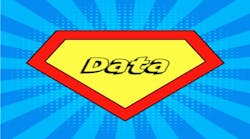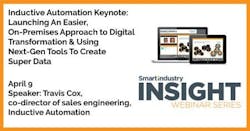We’re excited to kick off our INSIGHT webinar series in early April with a keynote presentation by Inductive Automation’s Travis Cox, who will dive into “Launching An Easier, On-Premises Approach to Digital Transformation & Using Next-Gen Tools To Create Super Data.” Today we chat with the co-director of sales engineering to preview his presentation, touching on the benefits of the on-premises approach and what, exactly, he means by ‘super data.’
Take a look…
Smart Industry: How does an on-premises approach to digital transformation differ from others? What are unique challenges / opportunities with this approach?
Travis: The world of OT is quite complex. OT encompasses machinery, physical plant equipment, and remote industrial software and hardware. There are lots of proprietary protocols and domain knowledge required to build a solution. There are also lots of brownfield devices that are extremely expensive to replace and typically run for 10-20 years. It is extremely important to bridge the brownfield world to a new architecture leveraging open standards and broaden access to data. That conversion needs to happen on-premise with edge computing. We can securely collect a larger amount of data with context and leverage other business systems and the cloud. Not to mention, that we can provide local control and visibility of the data along with edge computing right at the source.
Smart Industry: How is an on-premises approach getting easier with better technology / wider understanding of this approach?
Travis: There are a wide range of industrial hardware and software options for edge computing. This approach is easier because we can leverage tools to do this conversion without coding on operating systems. There is a wider understanding about the benefits of leveraging modern technology and open standards. These technologies allow us to collect and do more with data in a secure way, leveraging today's modern security encryption standards.
Smart Industry: That term—super data. How do you differentiate one type of data from another? What makes good data?
Travis: There are a lot of challenges in bridging the OT/IT gap to make use of IT services in the industrial-operating environments. To understand the difficulty of this process it is important to first understand the difference between OT data and IT data requirementsSmart Industry: Why is the repeatable element of this approach important?
Travis: The amount of data and the demand on that data is increasing every day. We need a solution that can scale, is cost effective, and is easy to maintain going forward. Leveraging tools is a perfect approach since this can be easily repeated from site to site. It allows us to provide a consistent model of the data in a complex and often variable world. We don't have to worry about writing code and our overall total cost of ownership is lower.
Smart Industry: Explain the process of bringing modules to the cloud.
Travis: There are two ways to leverage the cloud: integrate with cloud services and deploy solutions to the cloud. Edge computing allows us to do both. We can easily bring data to cloud services for long term storage, machine learning, analytics and more. The cloud is extremely scalable and easy to support. Deploying solutions to the cloud allows for automatic discovery of assets and provides an enhanced mobile-ready visualization solution to get data and dashboards to more people.




